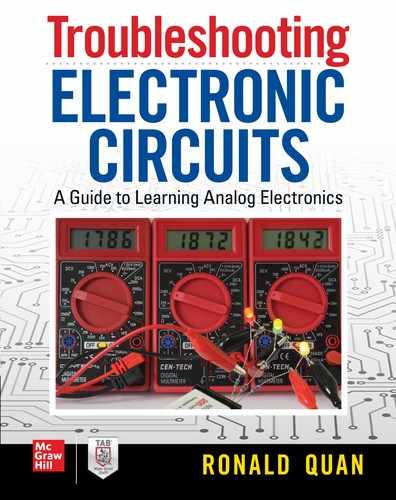CHAPTER 3
![]()
Power Sources: Batteries and Battery Holders, Safety Issues, and Voltmeters
We first cover different types of batteries and their holders. In particular, some holders have similar connectors and can cause the wrong voltage to be supplied to your circuits. Also, we will take a look at various digital voltmeters that will be one of your main troubleshooting tools.
Batteries
Many circuits today can be powered by about 3 volts to 9 volts. These voltages can be supplied by batteries connected in series. Although there are different types of 1.5-volt battery sizes, such as AAA, AA, C, and D, the most common ones to use are AA. There are the shorter-life carbon zinc or manganese batteries, and longer-life alkaline cells. All of these are “primary” cells, which must be discarded after they run out. That is, they are not rechargeable!
There are “standard” rechargeable batteries, such as nickel cadmium (NiCd) and nickel metal hydride (NiMh). However, these batteries will lose their charges within a few months.
A better investment is to buy “low self-discharge” nickel metal hydride (NiMh) batteries. Low self-discharge rechargeable batteries will retain about 80 percent capacity one year after a full charge. The typical capacity of these cells is about 2000 milliamp-hour for the AA, 4000 milliamp-hour for the C, and 8000 milliamp-hour for the D size.
Battery capacity in milliamp-hour gives us a good estimate of battery life based on current drain. For example, suppose you are powering an LED flashlight with an AA NiMh rated at 2000 milliamp-hour, and the LED flashlight drains 200 milliamps. We can then calculate the flashlight’s duration to give off light as:
time or duration = (battery capacity)/(current drain)
In this example, battery capacity for an AA cell is 2000 milliamp-hour, and current drain is 200 milliamp.
time or duration = (2000 milliamp-hour)/(200 milliamp) = 10 hours time or duration = 10 hours
Rechargeable NiMh 9-volt batteries also come in the low self-discharge variety.
Usually, the other key words to look out for in low self-discharge rechargeable batteries are
• “Ready to use”
• “Precharged” or “Pre-Charged” or “Factory Charged”
• “Charge Retention, up to 12 months” or “keeps charged up to 12 months”
• “Long shelf life”
Here are a few manufacturers of rechargeable long–shelf life batteries:
• Eneloop by Panasonic or Sanyo
• energyOn
• Eveready
• Rayovac
Note that NiMh batteries give about 1.25 volts per cell, but fortunately, most electronic circuits will operate in the 2.5-volt (2 cells in series) to 7.2-volt (6 cells in series) range.
See Figure 3-1, which shows various double layered AA cell battery holders.

FIGURE 3.1 AA battery holders for 4, 6, 8, and 10 cells.
Note the battery holders’ positive (+) and negative (–) polarity markings. The smaller connector on the left side of each battery holder is the positive terminal, while the larger diameter connector toward the right side is the negative terminal.
See Table 3-1 for a voltage summary on these holders.
TABLE 3.1 Nominal Output Voltages Based on Number of AA Cells

Some battery holders come in single layer construction. See Figure 3-2.

FIGURE 3.2 Flat battery holders with leads (red wire is positive and black wire is negative) and with connectors.
Battery holders with leads are preferred sometimes so that there is no chance of accidentally supplying the wrong voltage to a specific circuit. The reason is because if you set aside a circuit for a while, you may forget what the circuit voltage is. If it has a “9-volt” connector, then the first assumption is to connect 9 volts to the circuit, which may burn it out because the circuit may have 5-volt logic circuits. See Figures 3-3 and 3-4.
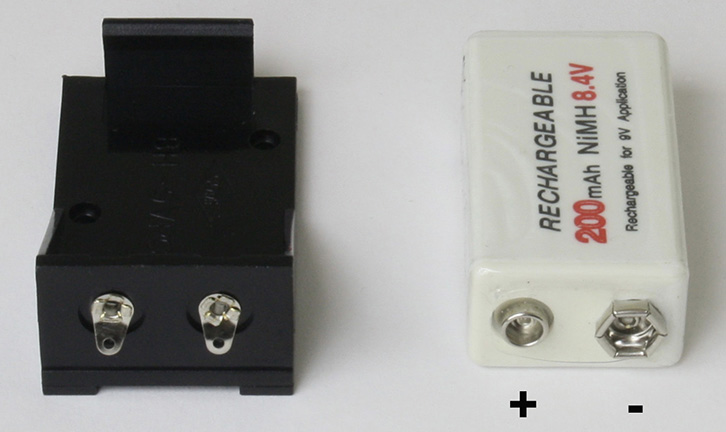
FIGURE 3.3 A 9-volt battery holder with tabs to solder wires to, and a rechargeable 9-volt battery.

FIGURE 3.4 A 3-volt battery holder, a battery connector where the red lead is positive and the black lead is negative, and a 9-volt battery.
Again, a Word of Caution
When working with battery connectors, you must keep track of your operating voltage. If we are not careful, we can mistakenly apply the wrong voltage to the circuit. See Figure 3-4, which shows two different battery voltage sources that have the same connector.
Because AA cell battery holders use the same battery connector as a 9-volt battery, we can inadvertently apply the wrong supply voltage to a circuit, which can destroy some of the electronic components. For example, if you are building a 3-volt (digital) logic circuit, then you can use the 3-volt battery holder with 2 AA cells and the battery connector in Figure 3-4. But it is possible, by accident, that the battery connector is snapped onto a 9-volt battery, which will most likely destroy the 3-volt logic circuit. So, we just need to be careful by labeling the battery connector with the operating voltage.
Expected Battery Capacity
You can use a low self-discharge 9-volt NiMh battery in many electronic circuits. Just be mindful that they have about 200 milliamp-hour capacity, which is about 10 percent of the AA cells that have generally about a 2000 millamp-hour rating. For projects draining less than 50 mA, the rechargeable 9-volt NiMh battery will work fine. Note that most 9-volt NiMh actually deliver about 9 volts (e.g., 7 cells at 1.25 volts each yield 8.75 volts).
Safety Considerations
If you are using rechargeable batteries, be sure to use only the chargers made for these types of batteries. For example, you can usually purchase a charger along with a set of rechargeable batteries.
Battery chargers are not to be used with primary batteries such as alkaline, carbon zinc, manganese, and especially lithium cells. For safe practice, do not ever charge any of these batteries!
We will now examine voltmeters, which can confirm the power or battery supply is providing the expected voltage. In particular we will be looking into digital voltmeters (DVMs), which can test voltages from batteries or DC power supplies.
Survey of Digital Voltmeters
The most basic and useful troubleshooting equipment that you can purchase is a volt-ohm-milliamp meter to test for voltage (volts), resistance (ohms), and current (milliamps). Today they are more widely known as digital voltmeters, or DVMs.
One of the basic rules in troubleshooting circuits is to check the power supply with a voltmeter. For example, when a circuit does not turn on, the first thing to check is whether the circuit is receiving the correct voltage. If the voltage is not present, sometimes it’s important to make sure that the power switch is turned on, or the wires from the power source are connected to the circuit.
The DVM can measure not only the voltage at the circuit, but also confirm with its ohm meter function that a switch or wire has continuity or low resistance.
For now, let’s take a look at some digital voltmeters, which are generally priced from about $6 for the basic ones to $150 for more precision measurements. We will see that because the DVM’s performance-to-price ratio has increased steadily over the years, you can invest in a very versatile DVM that measures not only the voltage, resistance, and current, but also measures characteristics in transistors, diodes, and capacitors.
With the DVM, we can test the battery voltage, and in some cases, you can purchase an inexpensive analog volt-ohm-milliamp meter that tests 1.5-volt and 9-volt batteries.
When troubleshooting a circuit, sometimes it helps to monitor voltage and current at the same time, or monitor two different voltage points. Because the prices for certain DVMs are relatively inexpensive, you can obtain two or three of these without breaking your budget.
Let’s take a look at two similar-looking DVMs in Figure 3-5.

FIGURE 3.5 Two similar DVMs but with vastly different performance levels.
The Lexon (on the left) or the equivalent DT832 DVM (not shown) is rather inexpensive ( approximately $5 to $17 as of 2019) and is good for many general measurements. If you compare the Lexon with the Extech, you will notice that the resistance range is limited to 2 million ohms (2000k), whereas the Extech goes up to 2000 million ohms (2000M). Another major difference is in their AC voltage range, which is much more extended down to 200 millivolts AC full scale for the Extech compared to 200 volts AC for the Lexon.
Also, if you notice in Figure 3-5, the Extech will measure capacitors, Cx, (up to 20 uf) and an AC signal’s frequency (Hz) up to 200 kHz, whereas the Lexon cannot do any of these measurements.
Note that both DVMs in Figure 3-5 require you to set the measurement range manually. For example, if you are measuring 10 volts DC, you should set the selector knob to “20.” Or if you are measuring a 1 million ohm resistor (1 mega ohm), the selector should be turned to “2000” as in 2000 kilo-ohm since 1 million ohms = 1000 kilo-ohms.
For $20 to $40, you can buy auto-ranging DVMs. See Figure 3-6. With these types of DVMs, the range is automatically set for highest accuracy by the DVM. However, you normally need to wait an extra second or two for the DVM to find the correct range.
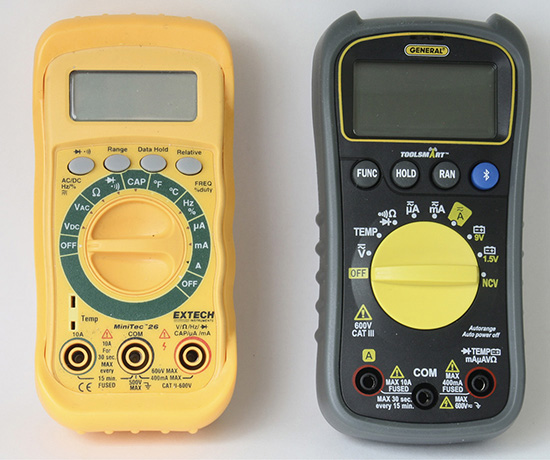
FIGURE 3.6 Two auto ranging DVMs by the Extech MN26 and General Tools and Instruments model TS04. Note: Extech replaced the MN26 with the MN36 DVM.
In general, most auto ranging DVMs have excellent measuring capabilities for voltage, current, and resistance. The Extech MN26 can also measure frequency (e.g., 1 Hz to 9.99 MHz) of an AC signal and capacitance (approximately 2 pf to 200 μf), along with temperature when a special probe is used.
The General Tools and Instrument DVM will measure voltage, current, resistance, and it has two or three other features. These are
• Battery tester for 1.5-volt and 9-volt batteries
• NCV detector that senses live AC power lines or wires by putting the DVM close by the outlets or walls
• Auto shutoff, which is very useful since some of us forget to turn off our DVMs
• Bluetooth capability to send measurement data to an iPhone or Android smartphone
Still in the $20 to $40 range, you can get larger-sized, manual-range DVMs. See Figure 3-7.
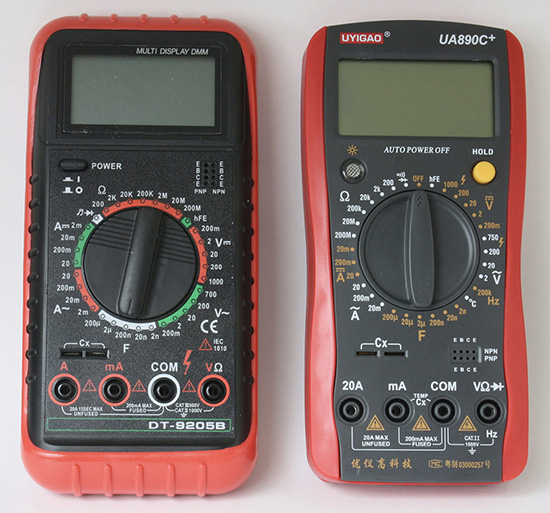
FIGURE 3.7 Two larger-sized DVMs, the DT-9205B and UA890C.
These DVMs are larger and are easier to read and have good overall measurement ranges. However, they do not have as much sensitivity on measuring current (e.g., 2 milliamps versus 200 micro amps for the inexpensive Lexon in Figure 3-5). But if you recall, it’s fine to have a second DVM, which can be something like the Lexon if you need to make more sensitive DC current measurements.
Again, note that the UA890C has the auto-shutoff feature, while this version of the DT-9205B does not. When I searched the web, I did find a “Best” DT-9205M that has “Auto Power Off ”to save on batteries.
Figure 3-8 shows a comparison with another equivalent Lexon digital voltmeter with the DT-9205B.

FIGURE 3.8 A comparison of a Harbor Freight Cen-Tech DVM with the DT-9205B.
The less than $10 Cen-Tech DVM has a slide switch for turning it on or off. It does have a battery tester mode for 1.5-volt and 9-volt batteries that the Lexon in Figure 3-5 does not. Note that it too can measure DC current down to 200 micro amps full scale.
There are more high-end DVMs that generally cost $80 to $150 such as the ones made by Keysight (formerly Agilent or Hewlett Packard) and by Fluke. See Figure 3-9.
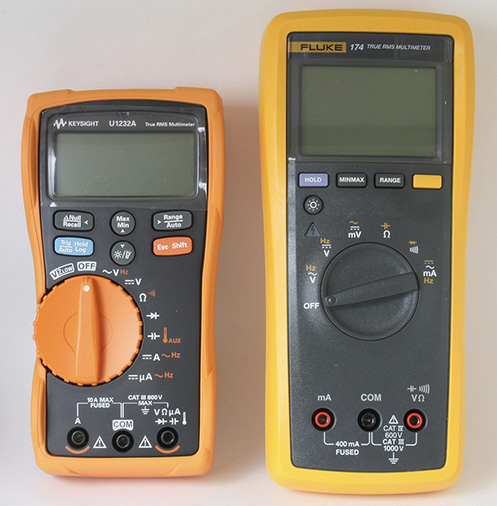
FIGURE 3.9 Keysight U1232A and Fluke 174 precision auto-ranging DVMs.
Both DVMs have the “True RMS” measurement system to accurately characterize AC signals.
On the Keysight DVM, there is a U1231A version that does not include measuring current. I would advise to buy a DVM that includes the three basic measurements: voltage, resistance, and current.
This finishes the survey on different DVMs that you will be using for troubleshooting. What I have found is that usually a basic DVM like the Cen-Tech in Figure 3-8 will work for about 90 percent of the time. Once in a while, you may need a DVM that measures capacitance such as the MN26 Extech in Figure 3-6 because it can measure lower value capacitances. Because the prices have come down quite a bit, the basic DVM (e.g., Cen-Tech) can be bought for about $6, and a versatile auto-ranging meter (e.g., Extech MN36, MN26, or MN26T) is in the $44 range. These meters are a good investment for testing parts of your circuits.
In the next chapter, we will look at some basic electronic parts such as resistors, capacitors, and semiconductors (diodes and transistors), which all can be measured and checked with some of these DVMs.
